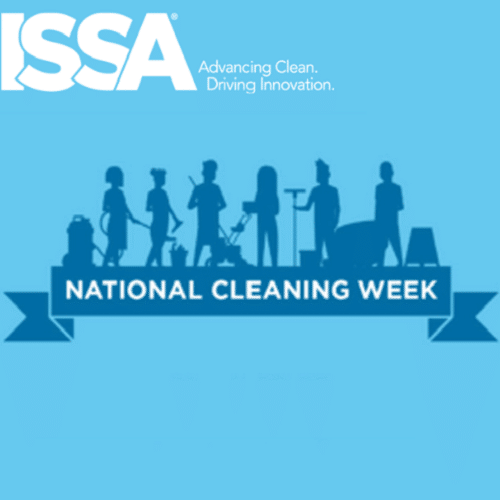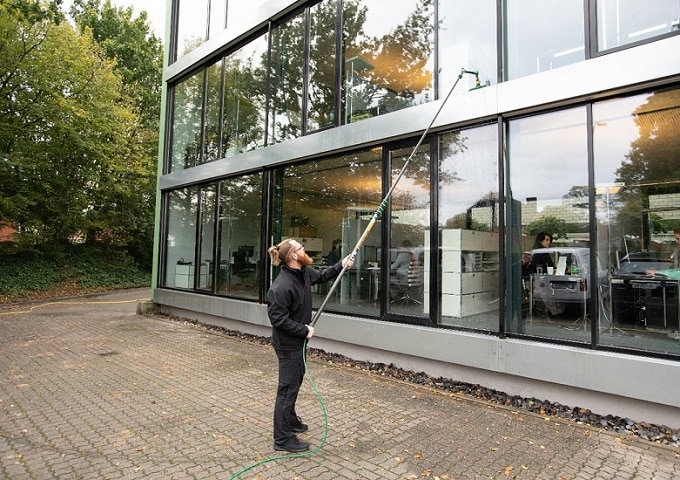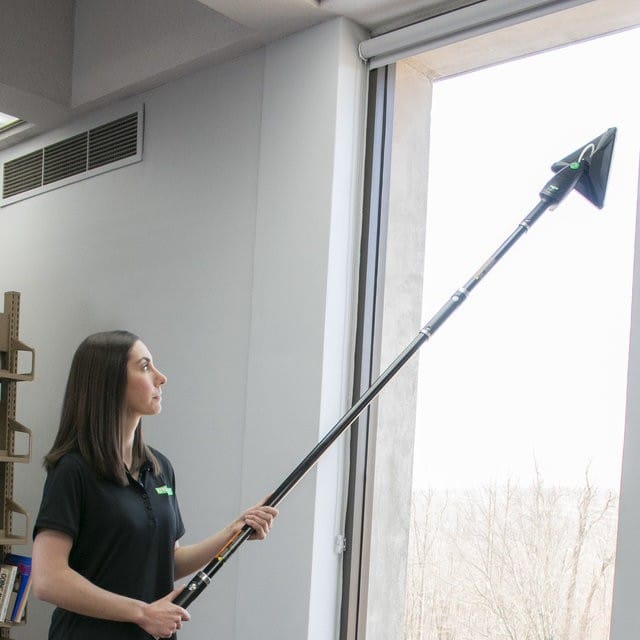
Spring Cleaning Safety: Commercial Cleaning Tools Designed for Injury Prevention
National Cleaning Week, March 27–April 2, 2022, represents a unique opportunity to celebrate the value of clean and raise public awareness to the industry’s commitment to maintaining healthy environments for workers and customers. As part of this week, Unger wants to highlight ways to safely transition your staff from winter to spring cleaning.
A popular tradition for households, Spring cleaning is also an opportune time for facilities to focus on deep cleaning, addressing specific problem areas and maintenance. Kicking off annually with National Cleaning Week, the benefits of a thoroughly planned facility spring cleaning extend from improved air quality to increased customer satisfaction.
While the results of spring cleaning efforts are highly desirable, the downside to this annual effort is that it unfortunately boasts a high rate of injuries, commonly stemming from falls, lifting heavy objects, chemical exposure and overexertion. For facility managers and building service contractors, the top item on their spring cleaning lists hopefully should be the safety of those performing the jobs at hand, starting with the equipment they use.
Spring Cleaning Safety Checklist
When transitioning from winter to spring cleaning, typically the focus is on problem areas or those most impacted by winter or neglected during poor weather conditions, including:
#1 Outdoor Window Cleaning
55% of first impressions are made by what we see, making spring cleaning windows on a building’s exterior a top priority. With professional window cleaners tasked with cleaning from the ground level up, fall risks and repetitive stress injuries are everyday safety concerns.
By replacing ladders and lifts to reach upper stories with window cleaning kits utilizing telescoping poles, you can minimize fall risks without jeopardizing the level of clean. In fact, when used in conjunction with a pure water cleaning system, they can improve the quality the clean.

#2 Ground Maintenance
Sidewalks, paths, parking lots and landscaped areas are the face of your facility, but in winter weather, you cannot always maintain them as you would during warmer seasons. Debris and litter often accumulate under snow, whether brought in naturally by patrons or moved around during ice and snow removal.
When selecting litter removal tools to support your spring cleaning efforts, there are some key design components that can make a big difference in minimizing any physical risks to cleaning staff. Common safety concerns when performing this type of work include user fatigue and strain when reaching above waist-high and overhead.
Using litter removal tools with a lightweight shaft will significantly reduce the effort and strain needed to perform these tasks. Just as important as the weight of the tool is the shaft length. The appropriate shaft length should allow the user to perform the task without bending and stretching repeatedly, which can lead to unnecessary strain. Additional nabber and grabber components, such as an ergonomic handle and rotating head, further allow staff to maintain a certain degree of comfort while removing litter.
#3 Floor Cleaning
Floors can pay the toll of winter weather when foot traffic carries in salt and ice melt residue, dirt and debris from wet roadways, parking lots and walkways. Taking special care to address any staining and damage will not only increase the overall cleanliness and visual appeal of the facility, but also protect the safety of patrons and longevity of the floors themselves.
It’s a misconception that the more solution is used when mopping, the cleaner the floors will be. However, the opposite is true. With too much floor cleaning solution, you can leave behind a residue and excess water, which will lead to more slippery floors. 85% of worker’s compensation claims are attributed to employees slipping on slick floors (Industrial Safety & Occupational Health Markets 5th edition), so using less solution when mopping is ideal. Using a mopping system that requires less solution, you’ll make your floors safer while cleaning just as effectively, if not more.
#4 High Access Cleaning and Dusting
To help improve indoor air quality, many facilities choose to deep clean their HVAC systems. While HVAC filters catch dust and allergens, removing excess dust and cobwebs from vents, ceiling fans and other high access areas will lighten the load on the system and decrease the amount of pollutants entering the air.
With the renewed emphasis on proper air ventilation, these HVAC filters need to be cleaned now more than ever, especially during spring cleaning time. But cleaning them presents risk.
Removing dust and cobweb accumulation from high levels typically would require the use of a ladder or lift. But keeping spring cleaning safety in mind, an alternative includes using a lightweight extension pole to access these hard to reach areas. Utilizing a high-quality telescopic pole, in combination with an adapter, you can add an array of dusting and high access cleaning accessories. Since the pole maintains its rigidity when extended, you can clean effectively and safely at a multitude of heights to improve and maintain indoor air quality.

#5 Indoor Window Cleaning
As with outdoor window cleaning, alternatives to indoor window cleaning tools for hard-to-reach windows include telescopic poles that enable you to clean high windows without the risk of falls. Sourcing an indoor window and glass cleaning solution that incorporates an ergonomic, lightweight telescoping pole in its design, you can also decrease other factors that jeopardize safety, especially in terms of repetitive stress injuries (RSIs). RSIs are more likely to occur when working in awkward positions, using equipment that’s poorly designed and lifting items that are awkwardly shaped or have a disproportionate weight distribution. Today’s window cleaning kits eliminate these risks and raise the bar on cleaning effectiveness.
Another similarity with indoor and outdoor window cleaning is potential exposure to airborne chemicals. Importantly, with indoor window cleaning, you don’t have the outside to naturally ventilate it. Its important to keep your staff safe from RSI’s and airborne chemicals. Thankfully, there are indoor window cleaning systems that can reduce both RSIs and chemical exposure.

Sourcing the Right Equipment to Support Safety
Spring cleaning, while it can be intense and tedious for facilities, there is a safer, more effective way to clean. Sourcing cleaning equipment that’s designed with the user top of mind will go a long way in protecting your staff from injury and improving the cleanliness and appearance of your facility. Click here to learn more about Unger’s portfolio of equipment optimized for spring cleaning.
